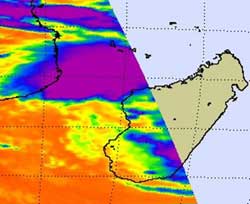NASA Satellite sees most of Cyclone Bingiza's rainfall over Mozambique Channel

NASA\'s Aqua satellite captured cold thunderstorm cloud tops (purple) to the north and west of the center of Tropical Storm Bingiza in this infrared image of Feb. 15 at 11:11 UTC. Credit: NASA JPL, Ed Olsen<br>
When NASA's Aqua satellite flew over Madagascar this morning, Feb. 15 at 11:11 UTC (6:11 a.m. EST), the Atmospheric Infrared Sounder (AIRS) instrument read the temperatures of the cold thunderstorm cloud tops in Cyclone Bingiza. Most of the strongest thunderstorms were north and west of the center of circulation already over the Mozambique Channel, while Bingiza's center remains over the western part of the island nation.
At 0900 UTC (4 a.m. EST) on Feb. 15, Tropical Cyclone Bingiza had maximum sustained winds near 35 knots (40 mph/64 kmh) so it was still a tropical storm. It was centered about 180 miles (289 km) north-northwest of Antananarivo, Madagascar, near 16.4 South and 45.2 East. It was moving west near 10 knots (11 mph/18 kmh).
At 1 a.m. EST (0600 UTC) Majunga, Madagascar reported north winds at 17 knots (20 mph/31 kmh) and an atmospheric pressure of 997 millibars. Majunga is a seaport city, a district, and a province on the northwest coast of Madagascar. Mahajanga is the capital city of the Boeny region as well as the Mahajanga Province.
Forecasters at the Joint Typhoon Warning Center expect Bingiza to move entirely into the eastern Mozambique Channel later today. A trough (elongated area) of low pressure will then push Bingiza parallel to the western coastline of Madagascar and forecasters expect the warm waters of the Channel and the low wind shear to allow it to re-strengthen. Bingiza is expected to turn toward the east and make a second landfall in southwestern Madagascar later this week.
Media Contact
More Information:
http://www.nasa.govAll latest news from the category: Earth Sciences
Earth Sciences (also referred to as Geosciences), which deals with basic issues surrounding our planet, plays a vital role in the area of energy and raw materials supply.
Earth Sciences comprises subjects such as geology, geography, geological informatics, paleontology, mineralogy, petrography, crystallography, geophysics, geodesy, glaciology, cartography, photogrammetry, meteorology and seismology, early-warning systems, earthquake research and polar research.
Newest articles

Sea slugs inspire highly stretchable biomedical sensor
USC Viterbi School of Engineering researcher Hangbo Zhao presents findings on highly stretchable and customizable microneedles for application in fields including neuroscience, tissue engineering, and wearable bioelectronics. The revolution in…

Twisting and binding matter waves with photons in a cavity
Precisely measuring the energy states of individual atoms has been a historical challenge for physicists due to atomic recoil. When an atom interacts with a photon, the atom “recoils” in…

Nanotubes, nanoparticles, and antibodies detect tiny amounts of fentanyl
New sensor is six orders of magnitude more sensitive than the next best thing. A research team at Pitt led by Alexander Star, a chemistry professor in the Kenneth P. Dietrich…





















